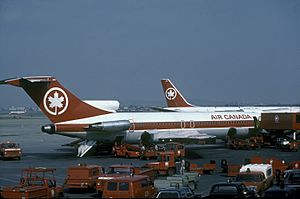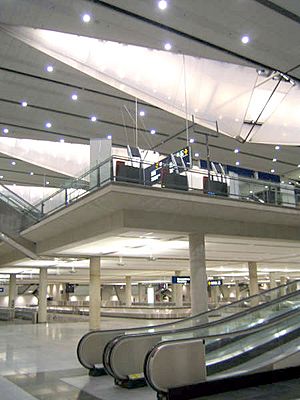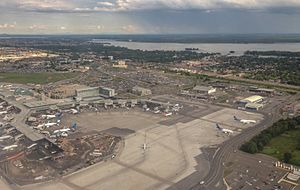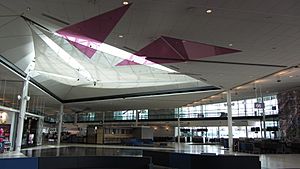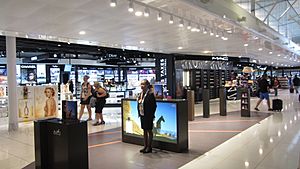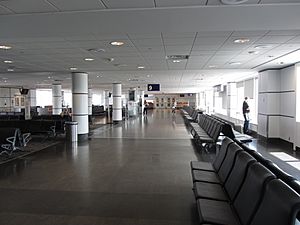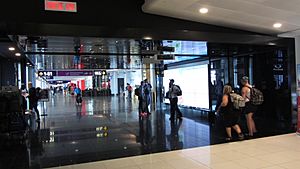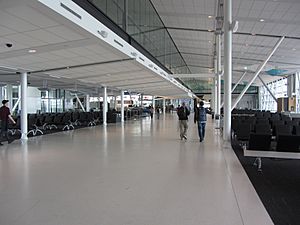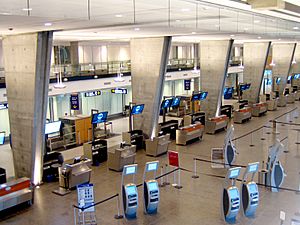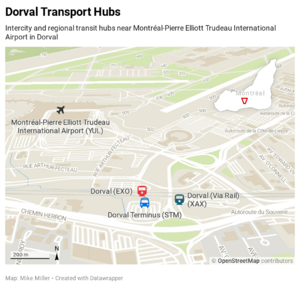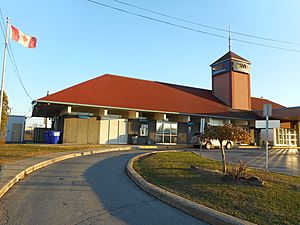Montréal–Trudeau International Airport facts for kids
Quick facts for kids
Montréal–Trudeau International Airport
Aéroport International Montréal-Trudeau
|
|||||||||||||||||||
|---|---|---|---|---|---|---|---|---|---|---|---|---|---|---|---|---|---|---|---|
 |
|||||||||||||||||||
 |
|||||||||||||||||||
| Summary | |||||||||||||||||||
| Airport type | Public | ||||||||||||||||||
| Owner | Transport Canada | ||||||||||||||||||
| Operator | Aéroports de Montréal | ||||||||||||||||||
| Serves | Greater Montreal and Eastern Ontario | ||||||||||||||||||
| Location | Dorval, Quebec, Canada | ||||||||||||||||||
| Opened | September 1, 1941 | ||||||||||||||||||
| Hub for | |||||||||||||||||||
| Focus city for | |||||||||||||||||||
| Time zone | EST (UTC–5) | ||||||||||||||||||
| • Summer (DST) | EDT (UTC–4) | ||||||||||||||||||
| Elevation AMSL | 118 ft / 36 m | ||||||||||||||||||
| Coordinates | 45°28′14″N 073°44′27″W / 45.47056°N 73.74083°W | ||||||||||||||||||
| Runway | |||||||||||||||||||
|
|||||||||||||||||||
| Statistics (2022) | |||||||||||||||||||
|
|||||||||||||||||||
|
Sources: Canada Flight Supplement and Transport Canada
Environment Canada Passenger traffic and movements from Aéroports de Montréal |
|||||||||||||||||||
Montréal–Trudeau International Airport (also known as Montréal–Trudeau or YUL) is a big airport in Dorval, Quebec, Canada. It's the only international airport serving Montreal. The airport is about 20 kilometers (12 miles) west of Downtown Montreal.
The airport is named after Pierre Trudeau, who was Canada's 15th Prime Minister. His son, Justin Trudeau, is the current Prime Minister. Montréal–Trudeau is managed by Aéroports de Montréal (ADM), a non-profit group. It is owned by Transport Canada.
This airport is the busiest in Quebec. It's also the third busiest in Canada for passenger traffic. In 2022, over 15.9 million passengers used it! It's a major gateway to Canada, with many flights going to other countries.
Montréal–Trudeau is a main hub for Air Canada, Canada's biggest airline. It also serves as a base for other airlines like Air Inuit and Air Transat. You can find non-stop flights from here to five different continents: Africa, Asia, Europe, North America, and South America.
Contents
Airport History
Starting Out in the 1940s
Back in the 1940s, Montreal's first airport, Montréal/Saint-Hubert Airport, was not big enough. So, a new airport was built at the Dorval Race Track. This spot was chosen because it had good weather and not many foggy days.
The airport opened on September 1, 1941, and was called Dorval Airport. It had three paved runways. By 1946, over 250,000 passengers used the airport each year. This number grew to over a million by the mid-1950s. During World War II, many Allied planes passed through Dorval on their way to England. For a while, Dorval was the main airport for flights crossing the Atlantic Ocean. It was the busiest airport in Canada.
Growing Bigger
In November 1960, the airport's name changed to Montreal–Dorval International Airport. A new, large terminal opened in December 1960. It cost $30 million to build. This terminal was the biggest in Canada and one of the largest in the world at the time. It was the main entry point to Canada for all flights from Europe. More than two million passengers used it every year.
Even with expansions, the government thought Dorval would become too busy by 1985. They planned to build a new, bigger airport called Montréal–Mirabel. The idea was to move all international flights (except those to the U.S.) to Mirabel in 1975.
Mirabel Airport: A Big Change
Mirabel Airport opened on November 29, 1975. It was designed to be huge, covering a very large area. Many international airlines moved their flights there. This meant Montréal–Dorval was then used mostly for flights within Canada and to the United States. The plan was to eventually close Dorval completely.
However, Mirabel did not get as much traffic as expected. Newer planes could fly longer distances without stopping in Montreal. Also, Montreal's economy slowed down. This made Mirabel's extra space unnecessary. People also preferred Dorval because it was closer to downtown Montreal. It was also difficult for passengers to connect flights if they had to travel between Dorval and Mirabel.
Because of these issues, most international airlines started flying to Toronto instead of Montreal. In 1997, international flights were moved back to Dorval. But it took time for airlines to return.
Back to Dorval and Modernization
With all international flights back at Montréal–Dorval by 1997, the airport became much busier. This helped it become a true hub again.
On January 1, 2004, the airport was renamed Montréal–Pierre Elliott Trudeau International Airport. This honored the former Prime Minister. Some people did not like the name change because Pierre Elliott Trudeau had supported closing Dorval in favor of Mirabel. Many Montrealers still call it "Dorval."
Operation Yellow Ribbon
After the September 11 attacks in 2001, many planes heading to the United States had to land elsewhere. Dorval Airport helped by taking in seven of these diverted flights. Mirabel International Airport also took in 10 flights. In total, 17 diverted flights landed in the Montreal area. This effort was called "Operation Yellow Ribbon."
75th Anniversary
In 2016, Montréal-Trudeau celebrated its 75th birthday! They had special events and exhibits to show the airport's history.
Airport Expansion
Terminal Upgrades (2000–2007)
Montréal–Trudeau went through a big upgrade to handle more passengers. In 2000, ADM announced a large expansion plan. The airport terminal had not changed much since 1960. With more passengers coming after international flights returned from Mirabel, a bigger terminal was needed.
The expansion included new areas for flights to the United States and other international destinations. A new area for U.S. flights opened in 2003. An international area with 11 gates opened in 2004. New customs and baggage claim areas opened in 2005. The airport can now serve 15 million passengers a year.
The airport was also made ready for the Airbus A380, a very large airplane. Gate 55 was built with two jet bridges to load passengers on both levels of the A380 at the same time. Air France was the first airline to use the A380 at Montreal in 2011.
New Hotel and U.S. Terminal (2006–2009)
In 2006, construction began on a new four-star Marriott hotel right above the U.S. departures terminal. It opened in 2009 with 279 rooms. On the same day, the U.S. departures terminal was also updated and expanded. This made the terminal much larger and more modern.
International Terminal Expansion (2011–2016)
From 2011 to 2016, the international terminal was expanded in two phases. This project cost about $620 million. Phase I, finished in 2012, added a new lounge and gate. Phase II, opened in 2016, added six new gates for large planes, including two for the Airbus A380. This expansion added 20,000 square meters of space with shops, restaurants, and a children's play area. It also features cool art installations.
In April 2016, a new food area called Haltes gourmandes (Gourmet Stops) opened. It has many restaurants.
Future Plans (2018–2030)
The airport has big plans for the future! By 2030, they plan to rebuild the parking lot with a green roof. They will also expand the drop-off area and build a new remote terminal. This new terminal will connect to the main building later on. These changes will help the airport handle even more passengers as it continues to grow.
Airport Layout
Runways
Montréal-Trudeau has three runways. Two run northeast-southwest, and one runs east-west.
| Number | Length | Width | Alignment |
|---|---|---|---|
| 06L/24R | 11,000 ft (3,400 m) | 200 ft (61 m) | Northeast-southwest |
| 06R/24L | 9,600 ft (2,900 m) | 200 ft (61 m) | Northeast-southwest |
| 10/28 | 7,000 ft (2,100 m) | 200 ft (61 m) | East-west |
Terminal Building
Montréal-Trudeau airport has one main building with two floors. It's divided into four main areas: the public area, the domestic area, the international area, and the U.S. flights area.
In the public area, you'll find check-in counters for flights within Canada, to other countries (except the U.S.), and to the U.S. There are also self-service check-in kiosks, shops, and cafes. The airport offers free Wi-Fi, luggage trolleys, ATMs, and nursing rooms. When you arrive from an international flight, you go through customs and then to the baggage claim. The airport also displays artworks to show Montreal's culture.
Domestic Area
The domestic area is for flights within Canada. It has 16 gates in the main building and 10 more gates in a satellite area connected by a tunnel. Some of these gates are used for smaller propeller planes. These parts of the airport are some of the oldest remaining from the original terminal.
International Area
The international area is for flights going to countries outside Canada and the United States. It has 18 gates. Here, travelers can find many shops, restaurants, cafes, and even spa services. There's also one of the biggest airport duty-free shops in Canada.
This area has lots of natural light from big windows and a skylight. A special artwork called Veil of Glass made of colored glass triangles lights up the space. You can also find murals and other art from Montreal museums here.
There's a large relaxation area where passengers can read books on their phones or e-readers. You'll find over 1000 chairs with charging stations and USB ports. There are also water bottle-filling stations.
U.S. Flights Area
The U.S. flights area is for all flights going to the United States. It has 18 gates. To get to these gates, passengers go through security and then through U.S. Customs and Border Protection. This area also has shops, restaurants, and rest zones. Some gates can be separated for extra security if needed.
Airport Lounges
Montréal-Trudeau has special lounges for frequent flyers. These include:
- Air Canada Maple Leaf Lounge (for domestic, international, and U.S. flights)
- Air France/KLM Lounge
- National Bank Lounge
- Desjardins Odyssey Lounge
Airlines and Destinations
Passenger Flights
Many airlines fly to and from Montréal-Trudeau, connecting Montreal to cities all over the world. Here are some of the airlines and where they fly:
| Airlines | Destinations | Refs |
|---|---|---|
| Aeroméxico | Mexico City | |
| Air Algérie | Algiers | |
| Air Canada | Barcelona, Bogotá, Brussels, Calgary, Casablanca, Delhi, Denver, Edmonton, Fort-de-France, Frankfurt, Geneva, Halifax, Houston–Intercontinental (begins October 29, 2023), Lisbon, London–Heathrow, Los Angeles, Lyon, Mexico City, Miami, Milan–Malpensa, Paris–Charles de Gaulle, Pointe-à-Pitre, Providenciales, Rome–Fiumicino, San Francisco, San José de Costa Rica–Juan Santamaría, São Paulo–Guarulhos, Tampa, Tokyo–Narita, Toronto–Pearson, Toulouse, Vancouver, Winnipeg Seasonal: Algiers, Amsterdam, Athens, Barbados, Buenos Aires–Ezeiza, Cairo, Cancún, Copenhagen, Dublin, Fort Lauderdale, Ixtapa/Zihuatanejo, Liberia (CR), Madrid (begins June 5, 2024), Moncton (begins October 29, 2023), Montego Bay, Nassau, New York–LaGuardia, Nice, Puerto Vallarta, Punta Cana, Reykjavík–Keflavík, San Diego, San José del Cabo (begins December 1, 2023), San Juan, Seattle/Tacoma, Tel Aviv, Venice, West Palm Beach |
|
| Air Canada Express | Atlanta, Bagotville, Bathurst, Boston, Charlottetown (ends October 28, 2023), Chicago–O'Hare, Dallas/Fort Worth, Deer Lake, Detroit, Fredericton, London (ON), Minneapolis/St. Paul, Newark, New York–JFK, New York–LaGuardia, Ottawa, Philadelphia, Rouyn-Noranda, Saint John (NB), Sept-Îles, Sydney (NS), Toronto–Billy Bishop, Toronto–Pearson, Washington–Dulles, Washington–National Seasonal: Gander, Houston–Intercontinental (ends October 28, 2023), Îles-de-la-Madeleine, Moncton, Nashville, Pittsburgh, Raleigh/Durham, Regina, Saskatoon |
|
| Air Canada Rouge | Cancún, Cayo Coco, Charlottetown, Cozumel, Fort Lauderdale, Fort McMurray, Kelowna, Las Vegas, Orlando, Punta Cana, Québec City, Samaná, San Salvador (Bahamas), St. John's (NL), Varadero Seasonal: Antigua, Curaçao, Holguin, La Romana (resumes December 17, 2023), Moncton, New Orleans (begins November 2, 2023), Phoenix–Sky Harbor, Puerto Plata, Santa Clara, Victoria |
|
| Air Creebec | Chibougamau, Chisasibi, Eastmain, Kuujjuarapik, Nemaska, Val-d'Or, Waskaganish, Wemindji | |
| Air France | Paris–Charles de Gaulle Seasonal: Pointe-à-Pitre |
|
| Air Inuit | Akulivik, Inukjuak, Ivujivik, Kangiqsujuaq, Kangirsuk, Kuujjuaq, Kuujjuarapik, La Grande, Puvirnituq, Quaqtaq, Quebec City, Salluit, Sanikiluaq, Schefferville, Sept-Îles, Umiujaq | |
| Air Saint-Pierre | Saint-Pierre | |
| Air Transat | Cancún, Cayo Coco, Fort Lauderdale, Holguín, Lisbon, London–Gatwick, Lyon, Málaga, Marseille, Miami, Montego Bay, Orlando, Paris–Charles de Gaulle, Port-au-Prince, Puerto Plata, Puerto Vallarta, Punta Cana, Samaná, Santa Clara, Toronto–Pearson, Varadero Seasonal: Acapulco, Amsterdam, Athens, Barcelona, Basel/Mulhouse, Bordeaux, Brussels, Calgary, Cartagena, Cozumel (resumes December 15, 2023), Fort-de-France, Havana, La Romana, Liberia (CR), Los Angeles, Madrid, Nantes, Nice, Pointe-à-Pitre, Porto, Québec City, Río Hato, Rome–Fiumicino, San Francisco, San José de Costa Rica–Juan Santamaría, San Juan, San Salvador, Sint Maarten, Toulouse, Vancouver, Venice |
|
| American Airlines | Dallas/Fort Worth, Miami | |
| American Eagle | Charlotte, Chicago–O'Hare, New York–LaGuardia, Philadelphia | |
| Arajet | Santo Domingo–Las Américas (begins November 7, 2023) | |
| Austrian Airlines | Vienna | |
| Azores Airlines | Seasonal: Ponta Delgada, Terceira | |
| British Airways | London–Heathrow | |
| Canadian North | Iqaluit, Kuujjuaq | |
| Copa Airlines | Panama City–Tocumen | |
| Corsair International | Seasonal: Paris–Orly | |
| Delta Air Lines | Atlanta, Minneapolis/St. Paul | |
| Delta Connection | Detroit, New York–JFK, New York–LaGuardia | |
| Emirates | Dubai–International | |
| Flair Airlines | Calgary, Edmonton, Halifax, Vancouver Seasonal: Cancún (begins October 30, 2023), Fort Lauderdale (begins October 29, 2023), Orlando/Sanford (begins October 29, 2023) |
|
| KLM | Amsterdam | |
| Lufthansa | Munich Seasonal: Frankfurt |
|
| Lynx Air | Calgary, Las Vegas (begins August 31, 2023), Orlando (begins November 2, 2023), St. John's (NL), Tampa (begins November 17, 2023) Seasonal: Vancouver |
|
| OWG | Cayo Coco, Holguín, Santa Clara, Varadero | |
| PAL Airlines | Baie-Comeau, Gaspé, Îles-de-la-Madeleine, Mont-Joli, Quebec City, Sept-Îles, Val-d'Or, Wabush | |
| Pascan Aviation | Bagotville, Îles-de-la-Madeleine, Mont-Joli, Quebec City, Sept-Îles, Wabush | |
| Porter Airlines | Halifax, Toronto–Billy Bishop, Toronto–Pearson | |
| Qatar Airways | Doha | |
| Royal Air Maroc | Casablanca | |
| Royal Jordanian | Amman–Queen Alia | |
| Sunwing Airlines | Cancún, Cayo Coco, Cayo Largo del Sur, Holguín, Montego Bay, Puerto Plata, Punta Cana, Santa Clara, Varadero Seasonal: Acapulco, Cienfuegos, Freeport, Liberia (CR), Manzanillo (Cuba), Mazatlán, Puerto Vallarta, Rio Hato, Roatán, St. Maarten, San José del Cabo |
|
| Swiss International Air Lines | Zürich | |
| TAP Air Portugal | Lisbon | |
| Tunisair | Tunis | |
| Turkish Airlines | Istanbul | |
| United Express | Chicago–O'Hare, Newark, Washington–Dulles | |
| WestJet | Calgary Seasonal: Edmonton, Toronto–Pearson, Vancouver |
Cargo Flights
Montréal-Trudeau also handles cargo flights, which carry goods instead of passengers.
| Airlines | Destinations | Refs |
|---|---|---|
| Glencore | Kattiniq/Donaldson |
Airport Statistics
Yearly Passenger Numbers
Here's how many passengers have used Montréal–Trudeau International Airport each year:
| Year | Passenger volume |
|---|---|
| 2023 (Jan-Apr) | 6,106,687 |
| 2022 | 15,973,242 |
| 2021 | 5,201,751 |
| 2020 | 5,437,210 |
| 2019 | 20,305,106 |
| 2018 | 19,428,143 |
| 2017 | 18,160,223 |
| 2016 | 16,589,067 |
| 2015 | 15,517,382 |
| 2014 | 14,840,067 |
| 2013 | 14,095,272 |
| 2012 | 13,809,820 |
| 2011 | 13,668,829 |
| 2010 | 12,971,339 |
| 2009 | 12,224,534 |
| 2008 | 12,813,320 |
| 2007 | 12,817,969 |
| 2006 | 11,441,202 |
Note: "Transborder" flights are to the United States. "International" flights are to other countries (not Canada or the U.S.). "Domestic" flights are within Canada. Passenger numbers dropped in 2020 and 2021 because of the COVID-19 pandemic.
Getting To and From the Airport
Public Transportation
The Société de transport de Montréal (STM) has several bus routes that serve the airport.
- Routes 204 Cardinal and 209 Sources run daily.
- Night buses 356 Lachine /Montreal–Trudeau /Des Sources and 378 Sauvé /Côte-Vertu /Montreal–Trudeau run at night.
- These buses can take you to the Dorval bus and train station.
The 747 Montreal-Trudeau/Downtown bus route is a special service. It runs 24 hours a day, every day of the year. This bus connects the airport to eight stops in downtown Montreal, including major metro stations.
| Société de transport de Montréal | |
|---|---|
| Route | Destination |
|
|
|
|
|
|
|
|
|
|
Train Connections
Via Rail, Canada's national train company, offers a free shuttle bus called "AirConnect." This bus takes passengers from the airport to Dorval station, which is about 2 kilometers (1.2 miles) away. From Dorval station, you can catch trains to cities like Quebec City, Ottawa, Kingston, and Toronto. The shuttle runs every 20-30 minutes.
Private Bus Services
Some airlines, like KLM Royal Dutch Airlines and Air France, offer private bus services for their customers. These buses connect Trudeau Airport to other cities like Ottawa and Quebec City.
By Car
The airport is easy to reach by car from Highway 20 or Highway 520. Highway 520 leads directly to the airport. There are designated areas for picking up and dropping off passengers. Plans are in place to improve the roads around the airport even more.
Future Connections
A new rapid transit network called Réseau express métropolitain (REM) is being built. It will connect Trudeau Airport to downtown Montreal, the North Shore, the South Shore, and the West Island. This train system will run almost all day, every day. Construction started in 2018, and the airport connection is expected to open by 2027.
Incidents and Accidents
- On November 29, 1963, Trans-Canada Air Lines Flight 831 crashed after leaving the airport. Sadly, all 118 people on board passed away.
- On June 18, 1998, Propair Flight 420 had a fire in its wing shortly after takeoff. The plane tried to land at Mirabel Airport, but the wing failed, and the plane crashed. All 11 people on board passed away.
- On June 5, 2015, WestJet flight 588 slid off the runway while landing. Luckily, no one was hurt.
- On July 9, 2023, a water truck caught fire under an Air Canada plane (Flight 885) while it was at the gate. Passengers were safely taken off the plane, and the fire was put out. No injuries were reported.
Airport Businesses
The airport has various businesses that provide fuel for planes and other services. Bombardier Aerospace also has a factory here where they build business jets.
See also
 In Spanish: Aeropuerto Internacional Pierre Elliott Trudeau para niños
In Spanish: Aeropuerto Internacional Pierre Elliott Trudeau para niños


